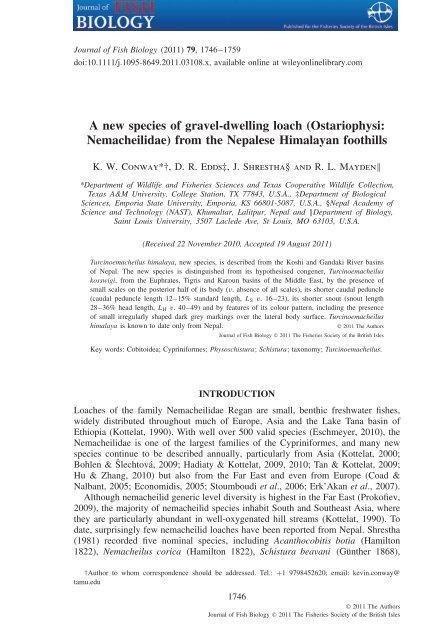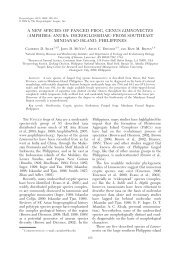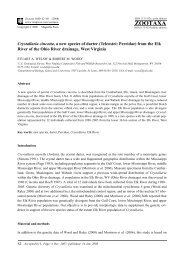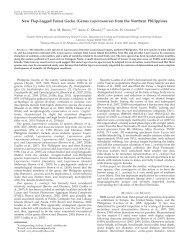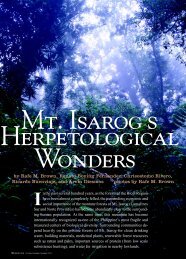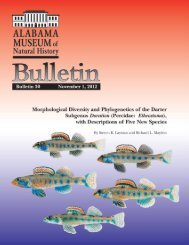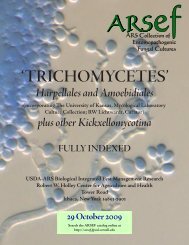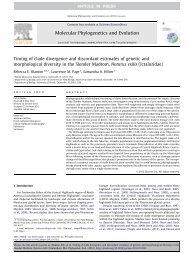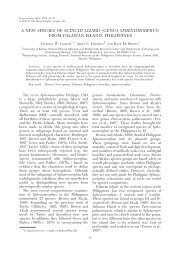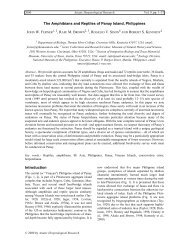(Ostariophysi: Nemacheilidae) from the Nepalese Himalayan foothills
(Ostariophysi: Nemacheilidae) from the Nepalese Himalayan foothills
(Ostariophysi: Nemacheilidae) from the Nepalese Himalayan foothills
Create successful ePaper yourself
Turn your PDF publications into a flip-book with our unique Google optimized e-Paper software.
Journal of Fish Biology (2011) 79, 1746–1759<br />
doi:10.1111/j.1095-8649.2011.03108.x, available online at wileyonlinelibrary.com<br />
A new species of gravel-dwelling loach (<strong>Ostariophysi</strong>:<br />
<strong>Nemacheilidae</strong>) <strong>from</strong> <strong>the</strong> <strong>Nepalese</strong> <strong>Himalayan</strong> <strong>foothills</strong><br />
K. W. Conway*†, D. R. Edds‡, J. Shrestha§ and R. L. Mayden‖<br />
*Department of Wildlife and Fisheries Sciences and Texas Cooperative Wildlife Collection,<br />
Texas A&M University, College Station, TX 77843, U.S.A., ‡Department of Biological<br />
Sciences, Emporia State University, Emporia, KS 66801-5087, U.S.A., §Nepal Academy of<br />
Science and Technology (NAST), Khumaltar, Lalitpur, Nepal and ‖Department of Biology,<br />
Saint Louis University, 3507 Laclede Ave, St Louis, MO 63103, U.S.A.<br />
(Received 22 November 2010, Accepted 19 August 2011)<br />
Turcinoemacheilus himalaya, new species, is described <strong>from</strong> <strong>the</strong> Koshi and Gandaki River basins<br />
of Nepal. The new species is distinguished <strong>from</strong> its hypo<strong>the</strong>sised congener, Turcinoemacheilus<br />
kosswigi, <strong>from</strong> <strong>the</strong> Euphrates, Tigris and Karoun basins of <strong>the</strong> Middle East, by <strong>the</strong> presence of<br />
small scales on <strong>the</strong> posterior half of its body (v. absence of all scales), its shorter caudal peduncle<br />
(caudal peduncle length 12–15% standard length, L S v. 16–23), its shorter snout (snout length<br />
28–36% head length, L H v. 40–49) and by features of its colour pattern, including <strong>the</strong> presence<br />
of small irregularly shaped dark grey markings over <strong>the</strong> lateral body surface. Turcinoemacheilus<br />
himalaya is known to date only <strong>from</strong> Nepal.<br />
© 2011 The Authors<br />
Journal of Fish Biology © 2011 The Fisheries Society of <strong>the</strong> British Isles<br />
Key words: Cobitoidea; Cypriniformes; Physoschistura; Schistura; taxonomy; Turcinoemacheilus.<br />
INTRODUCTION<br />
Loaches of <strong>the</strong> family <strong>Nemacheilidae</strong> Regan are small, benthic freshwater fishes,<br />
widely distributed throughout much of Europe, Asia and <strong>the</strong> Lake Tana basin of<br />
Ethiopia (Kottelat, 1990). With well over 500 valid species (Eschmeyer, 2010), <strong>the</strong><br />
<strong>Nemacheilidae</strong> is one of <strong>the</strong> largest families of <strong>the</strong> Cypriniformes, and many new<br />
species continue to be described annually, particularly <strong>from</strong> Asia (Kottelat, 2000;<br />
Bohlen & Ŝlechtová, 2009; Hadiaty & Kottelat, 2009, 2010; Tan & Kottelat, 2009;<br />
Hu & Zhang, 2010) but also <strong>from</strong> <strong>the</strong> Far East and even <strong>from</strong> Europe (Coad &<br />
Nalbant, 2005; Economidis, 2005; Stoumboudi et al., 2006; Erk’Akan et al., 2007).<br />
Although nemacheilid generic level diversity is highest in <strong>the</strong> Far East (Prokofiev,<br />
2009), <strong>the</strong> majority of nemacheilid species inhabit South and Sou<strong>the</strong>ast Asia, where<br />
<strong>the</strong>y are particularly abundant in well-oxygenated hill streams (Kottelat, 1990). To<br />
date, surprisingly few nemacheilid loaches have been reported <strong>from</strong> Nepal. Shrestha<br />
(1981) recorded five nominal species, including Acanthocobitis botia (Hamilton<br />
1822), Nemacheilus corica (Hamilton 1822), Schistura beavani (Gün<strong>the</strong>r 1868),<br />
†Author to whom correspondence should be addressed. Tel.: +1 9798452620; email: kevin.conway@<br />
tamu.edu<br />
1746<br />
© 2011 The Authors<br />
Journal of Fish Biology © 2011 The Fisheries Society of <strong>the</strong> British Isles
NEW NEMACHEILID LOACH FROM NEPAL 1747<br />
Schistura rupecula McClelland 1838 and S. r. inglisi Hora 1935. Rajbanshi (1982)<br />
increased <strong>the</strong> number to seven, with <strong>the</strong> addition of Schistura savona (Hamilton<br />
1822) and Schistura scaturigina (McClelland 1839), and Edds (1985) added one<br />
more, Schistura devdevi Hora 1935. Recently, Shrestha (2008) listed 12 species<br />
of nemacheilids <strong>from</strong> Nepal, with <strong>the</strong> addition of Schistura himachalensis (Menon<br />
1987), Schistura horai (Menon 1952), Schistura multifasciatus (Day 1878), Schistura<br />
prashadi (Hora 1921) and Schistura sikamaiensis (Hora 1921) [Shrestha (2008) made<br />
no mention of S. devdevi]. A number of Shrestha’s (2008) new records require fur<strong>the</strong>r<br />
investigation before <strong>the</strong>y should be considered part of <strong>the</strong> <strong>Nepalese</strong> ichthyofauna (e.g.<br />
S. prashadi, a species known o<strong>the</strong>rwise only <strong>from</strong> Nagaland, India; Menon, 1987).<br />
During ongoing investigations of <strong>the</strong> ichthyofauna inhabiting <strong>the</strong> hill streams of<br />
<strong>the</strong> Koshi and Gandaki River basins of Nepal, <strong>the</strong> authors became aware of a distinctive<br />
new nemacheilid loach that appears to belong to Turcinoemacheilus Bănărescu<br />
& Nalbant 1964, a genus reported to date only <strong>from</strong> <strong>the</strong> Euphrates-Tigris drainage<br />
of <strong>the</strong> Middle East (Bănărescu & Nalbant, 1964; Coad, 1995; Breil & Bohlen, 2001;<br />
Golzarianpour et al., 2009). The purpose of this paper is to provide a formal description<br />
for this new species.<br />
MATERIALS AND METHODS<br />
Specimens were captured in 1984, 1985, 1986, 1996 and 2008 by seine, electrofisher or<br />
dip net, killed by an overdose of anaes<strong>the</strong>tic, fixed in 10% formalin solution and preserved<br />
in 70% ethanol. Counts and measurements follow Kottelat (1990) except that <strong>the</strong> last two<br />
branched rays of <strong>the</strong> dorsal and anal fins, which share a single pterygiophore, are counted<br />
separately and that values for head length (L H ) reported here are equivalent to lateral head<br />
length of that author. All measurements were taken point to point on <strong>the</strong> left side of specimens<br />
with digital calipers and recorded to 0·1 mm. The head of one specimen was dissected,<br />
dehydrated with a graded series of ethanol, critical point dried (Denton DCP-1 critical point<br />
drier; Denton Vacuum; www.denton vacuum.com), placed on an aluminum stub and coated<br />
with gold (Denton Desk IV XLS; Denton Vacuum) for examination with scanning electron<br />
microscopy (SEM) using a Philips XL-20 SEM (Philips Electronics N.V.; www.philips.com).<br />
Five specimens were cleared and stained (c&s) following <strong>the</strong> protocol of Taylor & Van Dyke<br />
(1985). Meristic counts were obtained <strong>from</strong> c&s specimens with <strong>the</strong> aid of a Leica S8AP0<br />
stereomicroscope (www.leica-microsystems.com). Paired fin counts were obtained <strong>from</strong> <strong>the</strong><br />
left side of c&s specimens only. Numbers in paren<strong>the</strong>ses after a count indicate <strong>the</strong> frequency<br />
of that count. Meristic counts for Turcinoemacheilus kosswigi Bănărescu & Nalbant 1964 were<br />
obtained <strong>from</strong> Bănărescu & Nalbant (1964), Breil & Bohlen (2001) and Golzarianpour et al.<br />
(2009). All photographs were taken using a Leica DFC280 mounted on <strong>the</strong> aforementioned<br />
microscope. Illustrations were adapted <strong>from</strong> photographs using Abode Illustrator CS.<br />
A number of habitat measurements were obtained at localities sampled between 1984 and<br />
1986. Dissolved oxygen (DO) (ppm), pH and total hardness (mg l −1 CaCO 3 ) were determined<br />
with a Hach kit model AL-36B (Hach Co.; www.hach.com). Current speed (m s −1 ) was measured<br />
with a Gurley pygmy meter no. 625 (Gurley Precision Instruments; www.gurley.com)<br />
at 60% depth at 10 locations across <strong>the</strong> microhabitat where <strong>the</strong> species was captured; depth<br />
(cm) was determined with a metre stick. Substratum composition was qualitatively characterized<br />
by visually estimating <strong>the</strong> relative proportion of mud (256 mm) (Bain, 1999). Vegetation cover was visually estimated as per cent of <strong>the</strong> substratum<br />
covered by filamentous algae, submerged vegetation, emergent vegetation and organic<br />
debris.<br />
Specimens examined are housed at <strong>the</strong> American Museum of Natural History, New York<br />
(AMNH), Fischsammlung J. Freyhof, Berlin (FSJF), University of Kansas Natural History<br />
© 2011 The Authors<br />
Journal of Fish Biology © 2011 The Fisheries Society of <strong>the</strong> British Isles, Journal of Fish Biology 2011, 79, 1746–1759
1748 K. W. CONWAY ET AL.<br />
Museum and Biodiversity Research Center, Lawrence (KU), Oklahoma State University<br />
Department of Zoology Collection of Vertebrates, Stillwater (OSUS), Texas Cooperative<br />
Wildlife Collection, College Station (TCWC), Tribhuvan University Zoology Collection,<br />
Kathmandu (TZC), University of Michigan Museum of Zoology, Michigan (UMMZ), and<br />
<strong>the</strong> Zoological Institute and Museum, Hamburg (ZMH). Comparative materials examined are<br />
listed in Appendix.<br />
TAXONOMY<br />
TURCINOEMACHEILUS HIMALAYA NEW SPECIES<br />
(FIGS 1 AND 2)<br />
Nemacheilus shebbearei Hora: Edds (1989: 24, 29, 36, 38, 41, 45, 73, 76, 80, 91,<br />
93, 123, 125; 1993: 52, 55, 59), Edds et al. (2002: 546)<br />
Physoschistura elongata Sen & Nalbant in Singh, Sen, Banarescu & Nalbant:<br />
Shrestha (2008: 135, 331, Fig. 112)<br />
Holotype: KU 40558, 46·6 mm standard length L S ; Nepal: Bagmati Zone, Sindhupalchok<br />
District, Indrawati River at Melamchi Township, 27 ◦ 49 ′ 42·5 ′′ N; 85 ◦ 34 ′<br />
37·1 ′′ E, R. L. Mayden, K. W. Conway, K. Khanal & R. Napit 28–29 October 2008.<br />
Paratypes: KU 40279, 1, 33·2 mmL S ; Nepal: Palpa/Syangja, Kali Gandaki at<br />
Ramdi, 27 ◦ 53 ′ 60·00 ′′ N; 83 ◦ 37 ′ 59·88 ′′ E, 26 April 1996, D. Edds. KU 40278,<br />
1, 30·8 mmL S ; Nepal: Chitwan/Nawalparasi, Narayani River at Narayangarh, 27 ◦<br />
Fig. 1. Turcinoemacheilus himalaya, KU 40558, holotype, 46·6 mm standard length; Nepal: Bagmati Zone,<br />
Indrawati River at Melamchi township.<br />
© 2011 The Authors<br />
Journal of Fish Biology © 2011 The Fisheries Society of <strong>the</strong> British Isles, Journal of Fish Biology 2011, 79, 1746–1759
NEW NEMACHEILID LOACH FROM NEPAL 1749<br />
(a)<br />
(b)<br />
Fig. 2. (a)Turcinoemacheilus himalaya, KU 40557, paratype; Nepal: Bagmati Zone, Indrawati River at Melamchi<br />
township. (b) Turcinoemacheilus kosswigi.<br />
42 ′ 24·12 ′′ N; 84 ◦ 25 ′ 54·13 ′′ E, 23 April 1996, D. Edds. KU 40280, 9 (2 c&s),<br />
35·9–48·1 mmL S ; Nepal: Gulmi/Parbat, Gaundi River at Gumti, 28 ◦ 3 ′ 54·00 ′′ N;<br />
83 ◦ 33 ′ 35·99 ′′ E, 19 May 1996, D. Edds. KU 40281, 4, 20·8–39·4 mmL S ; Nepal:<br />
Tanahun, Seti River at Khairenitar, 28 ◦ 1 ′ 59·88 ′′ N; 84 ◦ 4 ′ 0·13 ′′ E, 15 June 1996,<br />
D. Edds. KU 40282, 1, 37·5 mmL S ; Nepal: Parbat, Lungdi River, purchased <strong>from</strong><br />
fishermen fishing 1 h walk north of Parse, c. 28 ◦ 10 ′ 0·12 ′′ N; 83 ◦ 48 ′ 0·00 ′′ E,<br />
3 September 1996, D. Edds. KU 40557, 14 (2c&s), 27·3–46·6 mmL S ; same data<br />
as holotype. OSUS 15908, 4, 24·6–46·3 mmL S ; Nepal: Gulmi, Kali Gandaki at<br />
confluence with Baandigarh River, 19 August 1984, D. Edds. KU 40568, 11 (1c&s<br />
1SEM), 18·1–52·6 mmL S ; Nepal: Bagmati Zone, Sindhupalchok District, Melamchi<br />
River 4·828 km (3 miles) upstream <strong>from</strong> confluence with Indrawati River, 27 ◦<br />
57 ′ 22 ′′ N; 85 ◦ 32 ′ 26.6 ′′ E, R. L. Mayden et al., 29 October 2008. OSUS 15621, 4,<br />
29·8–34·7 mmL S ; Nepal: Chitwan, Narayani River at Narayangarh, above irrigation<br />
building, 1 April 1984, D. Edds. OSUS 16314, 26, 24·7–46·6 mmL S ; Nepal:<br />
Gulmi, Kali Gandaki at confluence with Gaundi River near Phulbaari, 28 ◦ 3 ′ 49·00 ′′<br />
N; 83 ◦ 33 ′ 38·00 ′′ E, 20 January 1985, D. Edds. OSUS 16325, 7, 34·6–46·7 mm<br />
L S ; Nepal: Baglung, Kali Gandaki at Jyaamri Ghat, 22 January 1985, D. Edds.<br />
OSUS 16744, 25, 28·6–53·4 mmL S ; Nepal: Gulmi, Kali Gandaki at confluence<br />
with Gaundi River, 28 ◦ 3 ′ 49·00 ′′ N; 83 ◦ 33 ′ 38·00 ′′ E, 22 May 1985, D. Edds.<br />
OSUS 17197, 32, 22·7–49·6 mmL S ; Nepal: Gulmi, Kali Gandaki at confluence<br />
with Gaundi River, 28 ◦ 3 ′ 49·00 ′′ N; 83 ◦ 33 ′ 38·00 ′′ E, 21 May 1985, D. Edds. TCZ<br />
uncat., 3, 36·1–45·1 mmL S ; same data as holotype.<br />
Diagnosis: Turcinoemacheilus himalaya is distinguished <strong>from</strong> its only congener,<br />
T. kosswigi, by <strong>the</strong> presence of small scales on <strong>the</strong> posterior half of its body (v. scales<br />
© 2011 The Authors<br />
Journal of Fish Biology © 2011 The Fisheries Society of <strong>the</strong> British Isles, Journal of Fish Biology 2011, 79, 1746–1759
1750 K. W. CONWAY ET AL.<br />
Table I. Morphometric characters of holotype (KU 40558) and 20 paratypes (KU 40280,<br />
40557, 40568 and TCZ uncat.) of Turcinoemacheilus himalaya n. sp. expressed as a percentage<br />
of standard length (L S )orheadlength(L H )<br />
Holotype Range Mean ± s.d.<br />
L S 46·6 27·3–53·6<br />
As percentage of L S<br />
Body depth 11·4 9·2–11·9 10·8 ± 0·9<br />
Head length 19·3 18·3–20·7 19·7 ± 1·0<br />
Dorsal head length 18·2 16·6–19·8 18·5 ± 1·0<br />
Pre-dorsal length 54·5 53·2–57·0 55·3 ± 1·2<br />
Pre-pelvic length 50·4 47·8–52·5 50·3 ± 1·4<br />
Pre-anal length 75·5 75·5–80·1 78·4 ± 1·6<br />
Snout-anus 62·4 59·0–64·1 62·1 ± 1·5<br />
Caudal peduncle length 14·6 12·0–15·1 13·9 ± 0·9<br />
Caudal peduncle depth 7·9 6·6–8·5 7·8 ± 0·6<br />
Pectoral fin length 17·2 15·3–18·5 17·0 ± 0·8<br />
Pelvic fin length 14·8 13·7–16·8 14·9 ± 0·9<br />
As percentage of L H<br />
Head width 48·9 40·5–48·8 45·5 ± 2·7<br />
Head depth 36·7 34·2–41·5 38·4 ± 2·9<br />
Eye diameter 13·3 12·1–18·3 14·5 ± 1·8<br />
Snout length 36·7 28·1–36·7 33·9 ± 2·3<br />
Interorbital width 21·1 14·3–22·2 19·0 ± 2·4<br />
completely absent), its shorter caudal peduncle (caudal peduncle length 12–15%L S<br />
v. 16–23), its shorter snout (snout length 28–36% L H v. 40–49) and <strong>the</strong> presence of<br />
small irregularly shaped dark grey markings along <strong>the</strong> lateral side of body (v. absence<br />
of such markings).<br />
Description: general body shape as in Fig. 1. Largest specimen examined was<br />
53·6 mmL S (range 27·3–53·6 mm). Morphometric characters are listed in Table I.<br />
Body elongate, circular in cross-section anterior to dorsal-fin origin, becoming<br />
increasingly more ovoid in cross-section posterior to dorsal-fin origin. Body depth<br />
greatest midway between occiput and dorsal-fin origin, gently decreasing in depth<br />
towards caudal-fin base. Dorsal and ventral margins of caudal peduncle with low<br />
fleshy ridge. Head and eye small, snout moderate, rounded in dorsal view. Eye<br />
obliquely shaped, its ventral margin occluded in lateral view by a thick layer of skin.<br />
Mouth subterminal, strongly arched, with two pairs of rostral barbels and one pair<br />
of maxillary barbels (Fig. 3). Upper and lower lips fleshy, weakly papilliated. Lower<br />
lip with a triangular-shaped median interruption. Upper and lower jaws covered<br />
by a horny sheath. Processus dentiformis present on upper jaw, weakly developed.<br />
Deep groove between rostral fold and upper lip. Rostral fold not developed into lobes<br />
between barbels. Barbels weakly papilliated. Inner rostral barbel short, reaching to or<br />
slightly past base of outer rostral barbel when extended, outer rostral barbel reaching<br />
slightly past base of maxillary barbel when extended, maxillary barbel reaching to or<br />
slightly past horizontal through centre of eye when extended. Anterior nostril small,<br />
surrounded by a short flap. Posterior nostril larger than anterior, crescent shaped,<br />
narrowly separated <strong>from</strong> anterodorsal margin of eye by a narrow strip of skin.<br />
© 2011 The Authors<br />
Journal of Fish Biology © 2011 The Fisheries Society of <strong>the</strong> British Isles, Journal of Fish Biology 2011, 79, 1746–1759
NEW NEMACHEILID LOACH FROM NEPAL 1751<br />
(a)<br />
IRB<br />
RC<br />
ORB<br />
UL<br />
LJ<br />
LL<br />
(b)<br />
MB<br />
P<br />
1 mm<br />
20 µm<br />
Fig. 3. (a) Scanning electron micrograph picture of <strong>the</strong> mouthparts of Turcinoemacheilus himalaya, KU 40568,<br />
paratype, 38·8 mm standard length; Nepal: Bagmati Zone, Melamchi River, upstream <strong>from</strong> confluence<br />
with Indrawati River. (b) Close up of tastebud on surface of right outer rostral barbel, highlighted (a) ( ).<br />
IRB, inner rostral barbel; LJ, lower jaw; LL, lower lip; MB, maxillary barbel; ORB, outer rostral barbel;<br />
P, sensory pore of mandibular sensory canal; RC, rostral cap; UL, upper lip.<br />
Dorsal fin with iii.7.i(4) or iv.7.i(1) rays. Anal fin with iii.5.i rays. Principal caudal<br />
rays 9+8, dorsal procurrent rays 5(1), 7(3) or 8(1), ventral procurrent rays 3(1), 4(3)<br />
or 5(1). Pelvic fin with i.5.i rays, pectoral fin with i.7.i rays. Paired fins horizontally<br />
placed with large fleshy axillary skin-flap at base. Pelvic-fin origin ranging <strong>from</strong><br />
anterior to dorsal-fin origin to slightly posterior to dorsal-fin origin. Skin on ventral<br />
surface of unbranched pectoral- and pelvic-fin rays greatly thickened. Dorsal fin<br />
rounded, posterior edge straight. First dorsal-fin pterygiophore strongly bifurcated,<br />
inserted between vertebral centra 16/17(5). Anal fin small, rounded, posterior edge<br />
straight, posteriormost tip not reaching base of caudal fin when depressed. Anal-fin<br />
origin situated closer to caudal-fin base than dorsal-fin origin. First anal-fin pterygiophore,<br />
strongly bifurcated, inserted between haemal spines of vertebral centra 28/29<br />
(3) or 30/31(2). Caudal fin weakly forked, upper and lower lobes rounded, lower<br />
© 2011 The Authors<br />
Journal of Fish Biology © 2011 The Fisheries Society of <strong>the</strong> British Isles, Journal of Fish Biology 2011, 79, 1746–1759
1752 K. W. CONWAY ET AL.<br />
lobe slightly longer than upper lobe. Anus positioned slightly posterior to pelvic<br />
fins; <strong>the</strong> distance between anus and anal-fin origin much greater than <strong>the</strong> distance<br />
between anus and pelvic-fin origin.<br />
Total number of vertebrae 42-43, consisting of 21+21(1) 22+20(1), 22+21(2) or<br />
23+20(1) abdominal and caudal vertebrae. Total number of pleural ribs 12(2), 13(2)<br />
or 14(1), borne on vertebral centra 5-16(2), 5-17(2) or 5-18(1). Caudal fin skeleton<br />
with six hypurals. Second (free) uroneural of caudal skeleton and supraneurals posterior<br />
to <strong>the</strong> third absent. Anterior swimbladder chamber bilaterally paired, housed<br />
within a boney capsule formed by lateral process of second vertebral centrum and<br />
outer arm of os suspensorium. Boney capsule with two openings laterally and a large<br />
continuous flange of membrane bone along posteroventral edge. Neurocranium with<br />
large, irregularly shaped postepiphysial fontanelle, bordered by frontal, parietal and<br />
supraorbital bones. Fifth ceratobranchial with a single row of eight to nine small<br />
curved teeth with pointed tips (Fig. 4).<br />
Cephalic sensory system well-developed (Fig. 4). Supraorbital, infraorbital, preopercularmandibular<br />
and otic sensory canals enclosed in a series of short, tube-like<br />
(a)<br />
(b)<br />
K<br />
i<br />
iii<br />
ii<br />
Pmax<br />
Apal<br />
Max<br />
lOl<br />
(c)<br />
E<br />
LE<br />
Fr<br />
Asph<br />
Pa<br />
Apto<br />
Epo<br />
Soc<br />
Exoc<br />
Fig. 4. Aspects of <strong>the</strong> anatomy of Turcinoemacheilus himalaya, paratype, KU 40557, 46·6 mm standard length;<br />
Nepal: Bagmati Zone, Melamchi River, upstream <strong>from</strong> confluence with Indrawati River. (a) Skull in<br />
dorsal view, anterior to top, cephalic lateral line canal illustrated on left side only. Free sensory canal<br />
ossifications in dark grey, extraethmoid ossifications of right side in light grey. (b) Ceratobranchial 5, left<br />
side in dorsal view. Cartilage grey. (c) Stomach and anterior portion of intestine in ventral view, anterior<br />
to top. Scale bars equal 1 mm. Apal, autopalatine; Asph, autosphenotic; Apto, autopterotic; E, ethmoid<br />
complex; Epo, epioccipital; Exoc, exoccipital; Fr, frontal; K, kinethmoid; Le, lateral ethmoid; Max,<br />
maxilla; Pa, parietal; Pmax, premaxilla; Soc, supraoccipital; i, meseopreautopalatine; ii, 2nd preethmoid;<br />
iii, preautopalatine.<br />
© 2011 The Authors<br />
Journal of Fish Biology © 2011 The Fisheries Society of <strong>the</strong> British Isles, Journal of Fish Biology 2011, 79, 1746–1759
NEW NEMACHEILID LOACH FROM NEPAL 1753<br />
ossifications. Sensory canal ossifications without contact to underlying dermal ossifications,<br />
excluding parietal portion of supratemporal canal. Lateral line canal incomplete,<br />
extending as a continuous canal along body side until point below insertion of<br />
last dorsal-fin ray, continued <strong>the</strong>reafter as a series of short interrupted canals before<br />
terminating completely on body side opposite or slightly posterior to anal-fin origin.<br />
Scales small, cycloid, focus large, surrounded by a small number of circuli, and<br />
four to five weakly developed radii along posterior margin. Scales deeply embedded<br />
in skin and widely separate <strong>from</strong> each o<strong>the</strong>r, present on posterior half of body only.<br />
Stomach large, sac-like, intestine straight, uncoiled (Fig. 4).<br />
Sexual dimorphism: no obvious sexual dimorphism. Males appear more slender<br />
bodied than females. Both sexes exhibit a row of small tubercles along fin membranes<br />
between pectoral rays 1–4, which are better developed in males.<br />
Colouration: In alcohol, body background colour light cream to white. Occiput<br />
dark grey. Dorsal surface of body with a highly variable number of dark grey-brown<br />
saddles (ranging <strong>from</strong> 5 to 9, often confluent) that extend ventrally to form dark<br />
grey-brown bars, which are often forked ventrally, along lateral side of body. Dorsal<br />
saddles and lateral bars more intensely developed in smaller individuals (c. 20 mm<br />
L S ). Posteriormost bar, situated at base of caudal fin, much darker than more anterior<br />
bars in all individuals examined. Entire lateral side of body, excluding area directly<br />
below dorsal procurrent rays and area above ventral procurrent rays, speckled with<br />
small irregularly shaped dark grey markings. Such markings, which are generally<br />
more highly developed in larger specimens (>30 mm L S ), are heavily concentrated<br />
along horizontal septum along posteriormost part of caudal peduncle, producing (in<br />
combination with posteriormost body bar) a horizontal T-shaped marking at base of<br />
caudal fin. Ventral surface of body without pigmentation.<br />
Dorsal fin with a small dark spot anteriorly, at base of unbranched rays, and two<br />
weak irregular strips across centre, formed by aggregations of small melanophores<br />
on ei<strong>the</strong>r side of branching point in branched rays. Caudal fin with two irregular<br />
black vertical bars across centre, formed by aggregations of melanophores on ei<strong>the</strong>r<br />
side of branching point in branched principal caudal-fin rays. Pectoral fins with weak<br />
scattering of small melanophores over surfaces of 4–5 anteriormost rays. Anal and<br />
pelvic fins immaculate.<br />
In life, background colour light grey-cream dorsally and white ventrally [Fig. 2(a)].<br />
Dorsal saddles, lateral markings on body and markings on fins dark grey. Horizontal<br />
T-shaped marking at base of caudal fin prominent dark grey, highlighted by intense<br />
light areas without pigment dorsally and ventrally.<br />
Distribution, habitat, abundance and associated species: specimens were collected<br />
<strong>from</strong> large rivers (>10 m width) and medium-sized (5–10 m wide) tributaries of<br />
<strong>the</strong> Koshi and Gandaki River systems of eastern and central Nepal (Fig. 5). At <strong>the</strong><br />
type locality in <strong>the</strong> Koshi basin (Fig. 6), <strong>the</strong> Indrawati River is a pristine, fast to torrential<br />
flowing river, over a cobble and boulder substratum, with a well-developed<br />
gravel shoreline. At this site, T. himalaya was collected close to shore, toge<strong>the</strong>r<br />
with juveniles of Psilorhynchus pseudecheneis Menon & Datta 1964 (Psilorhynchidae)<br />
and an unidentified species of Schistura McClelland 1838 (<strong>Nemacheilidae</strong>),<br />
by sifting a dip net or small seine through gravel. O<strong>the</strong>r species collected at <strong>the</strong><br />
type locality, in adjacent habitats, included Botia almorhae Gray 1831 (Botiidae);<br />
Barilius vagra (Hamilton 1822), Opsarius bendelisis (Hamilton 1807), Schizothoraichthys<br />
sp., Schizothorax richardsonii (Gray 1832), Tor putitora (Hamilton 1822)<br />
© 2011 The Authors<br />
Journal of Fish Biology © 2011 The Fisheries Society of <strong>the</strong> British Isles, Journal of Fish Biology 2011, 79, 1746–1759
1754 K. W. CONWAY ET AL.<br />
80<br />
82 84 86 88 90<br />
30<br />
30<br />
28<br />
28<br />
100 km<br />
26<br />
80<br />
26<br />
82 84 86 88 90<br />
Fig. 5. Distribution of Turcinoemacheilus himalaya ( ). Type locality represented with an open symbol ( ).<br />
(Cyprinidae); Myersglanis blythii (Day 1870) and Pseudecheneis cf. crassicauda Ng<br />
& Edds 2005 (Sisoridae).<br />
In <strong>the</strong> Gandaki basin, specimens were collected (during each season of <strong>the</strong> year)<br />
in well-oxygenated, shallow riffles and runs with moderate to swift flow over clean,<br />
mainly pebble and cobble substratum (Table II). In 1984–1986, 140 specimens were<br />
Fig. 6. Indrawati River at Melamchi township. Type locality of Turcinoemacheilus himalaya.<br />
© 2011 The Authors<br />
Journal of Fish Biology © 2011 The Fisheries Society of <strong>the</strong> British Isles, Journal of Fish Biology 2011, 79, 1746–1759
NEW NEMACHEILID LOACH FROM NEPAL 1755<br />
Table II. Habitat characteristics at sites of 16 collections of Turcinoemacheilus himalaya in<br />
Nepal’s Gandaki River drainage in 1984–1986<br />
Environmental factor Mean ± s.d. Range<br />
Physicochemistry<br />
Temperature ( ◦ C) 18·2 ± 1·2 12–25<br />
Dissolved oxygen (mg l −1 ) 11·1 ± 0·5 8–15<br />
pH 8·1 ± 0·1 7·5–8·5<br />
Total hardness (mg l −1 ) 146·0 ± 5·4 103–171<br />
Current velocity (m s −1 ) 0·5 ± 0·1 0·2–0·9<br />
Water depth (cm) 27·6 ± 4·2 13–66<br />
Substratum composition<br />
Silt (256 mm) 6·2 ± 2·1 0–35<br />
Vegetation cover (%)<br />
Filamentous algae 11·5 ± 3·1 0–30<br />
Submerged
1756 K. W. CONWAY ET AL.<br />
1991 (Sisoridae); Xenentodon cancila (Hamilton 1822) (Belonidae); Pseudambassis<br />
baculis (Hamilton 1822) and Pseudambassis ranga (Hamilton 1822) (Ambassidae).<br />
In 1996, 19 individuals were captured in six collections at 56 sites sampled, with one<br />
to nine individuals per collection. O<strong>the</strong>r species not previously collected at Gandaki<br />
basin sites of T. himalaya occurrence included Anguilla bengalensis (Gray 1831)<br />
(Anguillidae); Semiplotus modestus Day 1870 (Cyprinidae); Glyptothorax gracilis<br />
(Gün<strong>the</strong>r 1864), Glyptothorax telchitta (Hamilton 1822) and Pseudecheneis eddsi<br />
Ng 2006 (Sisoridae).<br />
Etymology: From <strong>the</strong> Sanskrit (Hima-Alaya), meaning ‘adobe of snow’, in<br />
reference to <strong>the</strong> <strong>Himalayan</strong> Mountain Range to which <strong>the</strong> species is endemic.<br />
DISCUSSION<br />
Bănărescu & Nalbant (1964) provided a very brief diagnosis for Turcinoemacheilus<br />
in <strong>the</strong>ir review of <strong>the</strong> loaches of Turkey: ‘Körper niedrig, gestreckt und dick,<br />
vollständig schuppenlos. Die Seitenlinie sehr kurz. Afteröffnung weit nach vorn<br />
gedrängt, näher der Bauchflossenbasis als dem Ansatz der Afterflosse gelegen. Ansatz<br />
der Rückenflosse hinter dem Hinterrand der Bauchflossen. Schwanzflosse schwach<br />
eingebuchtet; alle Flossen sind klein und mehr oder weniger abgerundet.’ [Body narrow,<br />
elongate and thick, entirely scaleless. The lateral line very short. Anus displaced<br />
far anteriorly, closer to <strong>the</strong> pelvic fins than to <strong>the</strong> anterior base of anal fin. Anterior<br />
base of dorsal fin behind posterior tip of pelvic fins. Caudal fin slightly emarginated;<br />
all fins small and more or less rounded.]. Turcinoemacheilus himalaya exhibits all<br />
<strong>the</strong>se diagnostic characteristics except for <strong>the</strong> presence of scales along <strong>the</strong> posterior<br />
half of <strong>the</strong> body, which serves to distinguish <strong>the</strong> new species <strong>from</strong> its only congener,<br />
T. kosswigi. The two species of Turcinoemacheilus are fur<strong>the</strong>r distinguished by a<br />
number of morphometric characters, including caudal peduncle length (12–15% L S<br />
in T. himalaya v. 16–23 in T. kosswigi) and snout length (28–36% L H in T. himalaya<br />
v. 40–49 in T. kosswigi), and by differences in pigmentation (entire lateral side of<br />
body speckled with small irregularly shaped dark grey markings in T. himalaya v.<br />
absence of such markings in T. kosswigi).<br />
Previous authors have considered specimens of T. himalaya to belong to ei<strong>the</strong>r<br />
N. shebbearei (McClelland 1839) (Edds, 1989, 1993; Edds et al., 2002) or<br />
P. elongata (Shrestha, 2008). Turcinoemacheilus himalaya is easily distinguished<br />
<strong>from</strong> N. shebbearei (currently placed in <strong>the</strong> synonymy of S. scaturigina, following<br />
Menon, 1987) and P. elongata by <strong>the</strong> position of its anus, which is situated close<br />
behind <strong>the</strong> pelvic fins (v. situated closer to <strong>the</strong> anal fin than pelvic fins in both<br />
N. shebbearei and P. elongata; Hora, 1935; Singh et al., 1982). Turcinoemacheilus<br />
himalaya is fur<strong>the</strong>r distinguished <strong>from</strong> N. shebbearei by <strong>the</strong> position of <strong>the</strong> pelvic<br />
fins in relation to <strong>the</strong> dorsal fin (pelvic fins inserted anterior or directly opposite<br />
dorsal-fin origin in T. himalaya v. pelvic fins inserted posterior to dorsal-fin origin<br />
in N. shebbearei) and by <strong>the</strong> absence (v. presence) of a sexually dimorphic suborbital<br />
flap in males (Hora, 1935). It is fur<strong>the</strong>r distinguished <strong>from</strong> P. elongata by <strong>the</strong><br />
absence (v. presence) of <strong>the</strong> posterior chamber of <strong>the</strong> swimbladder and <strong>the</strong> absence<br />
(v. presence) of an intestinal coil (Singh et al., 1982). Turcinoemacheilus himalaya<br />
is distinguished <strong>from</strong> all o<strong>the</strong>r members of <strong>the</strong> <strong>Nemacheilidae</strong> reported <strong>from</strong> Nepal<br />
to date (Shrestha, 1981, 2008) by <strong>the</strong> anterior position of its anus.<br />
© 2011 The Authors<br />
Journal of Fish Biology © 2011 The Fisheries Society of <strong>the</strong> British Isles, Journal of Fish Biology 2011, 79, 1746–1759
NEW NEMACHEILID LOACH FROM NEPAL 1757<br />
Turcinoemacheilus himalaya appears to be endemic to Nepal and is known, to<br />
date, only <strong>from</strong> <strong>the</strong> upper reaches of <strong>the</strong> Koshi River basin and <strong>the</strong> hills and Inner<br />
Tarai of <strong>the</strong> Gandaki River basin. Like its congener, it appears to be relatively rare,<br />
found in only 22 of 212 collections in <strong>the</strong> Gandaki system in 1984–1986 and 1996,<br />
much less common than most o<strong>the</strong>r loaches in Nepal, and is typically present in low<br />
abundance at sites where it is found. This small benthic fish appears to be sensitive to<br />
pollution, as it was absent in sampling <strong>from</strong> areas where it had previously occurred in<br />
<strong>the</strong> Narayani River, Nepal, following dumping of paper mill effluent that decreased<br />
dissolved oxygen and increased alkalinity, silt substratum and plant fibre detritus<br />
(Edds et al., 2002). This raises concern for conservation of <strong>the</strong> species, given <strong>the</strong><br />
deterioration of Nepal’s riverine ecosystems (Edds, 2007).<br />
The discovery of T. himalaya is noteworthy not only because it represents a new<br />
generic record for Nepal but also because it represents <strong>the</strong> first record of Turcinoemacheilus<br />
outside of <strong>the</strong> Tigris-Euphrates drainage. Given <strong>the</strong> specific habitat<br />
requirements of Turcinoemacheilus (i.e. gravel beds with a strong current in <strong>the</strong><br />
upper reaches of rivers; Breil & Bohlen, 2001; Golzarianpour et al., 2009), it is<br />
possible that additional populations of Turcinoemacheilus await discovery in remote<br />
regions of Iran, Afghanistan, Pakistan and India.<br />
The authors thank R. Thiel and I. Eidus (ZMH) for access to radiographs and images of<br />
<strong>the</strong> type series of T. kosswigi, and A. Bentley (KU), J. Freyhof (FSJF), T. Echelle (OSUS),<br />
D. Nelson (UMMZ) and B. Brown (AMNH) for access to museum specimens under <strong>the</strong>ir<br />
care. The authors are particularly grateful to J. Bohlen and J. Freyhof for sharing information<br />
and images of T. kosswigi, R. Britz for translating German text and examining specimens of<br />
T. kosswigi, M. Kottelat, J. Bohlen and R. Britz for discussions about nemacheilid genera,<br />
G. W. Lange (St Louis, MO) for photographing <strong>the</strong> holotype (Fig. 1), A. Conway for help<br />
in collecting morphometrics and D. Siegel (Saint Louis University) and D. Sever (Sou<strong>the</strong>astern<br />
Louisiana University) for access to, and help with, SEM facilities (equipment time<br />
on which was funded via NSF DEB-0809831 to D. Sever). The authors are particularly<br />
grateful to J. Freyhof for valuable comments and suggestions on an earlier version of this<br />
manuscript. Finally, <strong>the</strong> authors thank those who provided field assistance in Nepal, including<br />
A. B. Gurung, K. Khanal and R. Napit, and <strong>the</strong> <strong>Nepalese</strong> Department of National Parks and<br />
Wildlife Conservation for granting permits. This research was supported by funds <strong>from</strong> <strong>the</strong><br />
National Geographic Society Committee for Research and Exploration, Wildlife Conservation<br />
International, <strong>the</strong> Explorers Club, <strong>the</strong> Fulbright program, Oklahoma State University,<br />
<strong>the</strong> University of Kansas Natural History Museum, <strong>the</strong> Emporia State University Faculty<br />
Research and Creativity Committee (all to D.R.E.), <strong>the</strong> National Science Foundation (NSF<br />
DEB-0808446 to R.L.M. and KWC and EF 0431326 to R.L.M.) and Texas Agrilife Research<br />
(to K.W.C.). This is publication number 1418 of <strong>the</strong> Texas Cooperative Wildlife Collection.<br />
References<br />
Bain, M. B. (1999). Substrate. In Aquatic Habitat Assessment: Common Methods. (Bain, M. B.<br />
& Stevenson, N. J., eds), pp. 95–100. Be<strong>the</strong>sda, MD: American Fisheries Society.<br />
Bănărescu, P. & Nalbant, T. T. (1964). Süsswasserfische der Türkei. 2. Teil Cobitidae. Mitteilungen<br />
aus dem Hamburgischen Zoologischen Museum und Institut 61, 159–201.<br />
Bohlen, J. & Ŝlechtová, V. (2009). Schistura udomritthiruji, a new loach <strong>from</strong> sou<strong>the</strong>rn Thailand<br />
(Cypriniformes: <strong>Nemacheilidae</strong>). Ichthyological Exploration of Freshwaters 20,<br />
319–324.<br />
Breil, M. & Bohlen, J. (2001). First record of <strong>the</strong> loach fish Turcinoemacheilus kosswigi in<br />
<strong>the</strong> basin of river Euphrates with first observations on habitat and behaviour. Zoology<br />
in <strong>the</strong> Middle East 23, 71–76.<br />
© 2011 The Authors<br />
Journal of Fish Biology © 2011 The Fisheries Society of <strong>the</strong> British Isles, Journal of Fish Biology 2011, 79, 1746–1759
1758 K. W. CONWAY ET AL.<br />
Coad, B. W. 1995. Freshwater fishes of Iran. Acta scientiarum naturalium Academiae scientiarum<br />
Bohemicae – Brno 29, 1–64.<br />
Coad, B. W. & Nalbant, T. T. (2005). A new genus and a new species of a remarkable<br />
nemacheilid fish <strong>from</strong> Iran (Pisces: <strong>Ostariophysi</strong>: <strong>Nemacheilidae</strong>). Travaux du Museum<br />
d’Histoire Naturelle “Grigore Antipa” 48, 303–308.<br />
Economidis, P. S. (2005). Barbatula pindus, a new species of stone loach <strong>from</strong> Greece<br />
(Teleostei: Balitoridae). Ichthyological Exploration of Freshwaters 16, 67–74.<br />
Edds, D. R. (1985). New records of fish species for Nepal. Journal of <strong>the</strong> Natural History<br />
Museum (Nepal) 9, 41–46.<br />
Edds, D. R. (1989). Multivariate analysis of fish assemblage composition and environmental<br />
correlates in a <strong>Himalayan</strong> river – Nepal’s Kali Gandaki/Narayani. PhD Dissertation,<br />
Oklahoma State University, Stillwater, OK.<br />
Edds, D. R. (1993). Fish assemblage structure and environmental correlates in Nepal’s Gandaki<br />
River. Copeia 1993, 48–60.<br />
Edds, D. R. (2007). Fishes in Nepal: ichthyofaunal surveys in seven nature reserves. Ichthyological<br />
Exploration of Freshwaters 18, 277–287.<br />
Edds, D. R., Gillette, D. P., Maskey, T. M. & Mahato, M. (2002). Hot-soda process paper<br />
mill effluent effects on fishes and macroinvertebrates in <strong>the</strong> Narayani River, Nepal.<br />
Journal of Freshwater Ecology 17, 543–554.<br />
Erk’Akan, F., Ozeren, S. C. & Nalbant, T. T. (2007). Seven new species of Barbatula, three<br />
new species of Schistura and a new species of Seminemacheilus (<strong>Ostariophysi</strong>: Balitoridae:<br />
Nemacheilinae) <strong>from</strong> Turkey. Journal of Fisheries International 2, 69–85.<br />
Golzarianpour, K., Abdoli, A., Kiabi, B. H. & Freyhof, J. (2009). First record of <strong>the</strong> miniature<br />
loach Turcinoemacheilus kosswigi (Teleostei: <strong>Nemacheilidae</strong>) in <strong>the</strong> Karoun drainage,<br />
Iran. Zoology of <strong>the</strong> Middle East 47, 57–62.<br />
Hadiaty, R. K. & Kottelat, M. (2009). Nemacheilus tebo, a new loach <strong>from</strong> Sangkulirang<br />
Karst, East Kalimantan, Indonesia (Teleostei: <strong>Nemacheilidae</strong>). The Raffles Bulletin of<br />
Zoology 57, 119–125.<br />
Hadiaty, R. K. & Kottelat, M. (2010). Nemacheilus marang, a new loach (Teleostei:<br />
<strong>Nemacheilidae</strong>) <strong>from</strong> Sangkulirang karst, eastern Borneo. Zootaxa 2557, 39–48.<br />
Hora, S. L. (1935). Notes on fishes in <strong>the</strong> Indian Museum. XXIV. Loaches of <strong>the</strong> genus<br />
Nemacheilus <strong>from</strong> eastern Himalayas, with <strong>the</strong> description of a new species <strong>from</strong><br />
Burma and Siam. Records of <strong>the</strong> Indian Museum (Calcutta) 37, 49–67.<br />
Hu, Y.-T. & Zhang, E. (2010). Homatula pycnolepis, a new species of nemacheiline loach<br />
<strong>from</strong> <strong>the</strong> upper Mekong drainage, South China (Teleostei: Balitoridae). Ichthyological<br />
Exploration of Freshwaters 21, 51–62.<br />
Kottelat, M. (1990). Indochinese Nemacheilines. A Revision of Nemacheiline Loaches (Pisces:<br />
Cypriniformes) of Thailand, Burma, Laos, Cambodia and Sou<strong>the</strong>rn Vietnam. München:<br />
Verlag Dr, Friedrich Pfeil.<br />
Kottelat, M. (2000). Diagnoses of a new genus and 64 new species of fishes <strong>from</strong> Laos<br />
(Teleostei: Cyprinidae, Balitoridae, Bagridae, Syngnathidae, Chaudhuriidae and<br />
Tetraodontidae). Journal of South Asian Natural History 5, 37–82.<br />
Menon, A. G. K. (1987). The Fauna of India and <strong>the</strong> Adjacent Countries. Pisces. Vol.IV,<br />
Part 1. Calcutta: Zoological Survey of India.<br />
Prokofiev, A. M. (2009). Problems of <strong>the</strong> classification and phylogeny of nemacheiline loaches<br />
of <strong>the</strong> group lacking <strong>the</strong> preethmoid I (Cypriniformes: Balitoridae: Nemacheiline).<br />
Journal of Ichthyology 49, 874–898.<br />
Rajbanshi, K. G. (1982). A General Bibliography on Fish and Fisheries of Nepal. Kathmandu:<br />
Royal Nepal Academy.<br />
Shrestha, J. (1981). Fishes of Nepal. Kathmandu: Curriculum Development Centre, Tribhuvan<br />
University.<br />
Shrestha, T. K. (2008). Ichthyology of Nepal. A Study of Fishes of <strong>the</strong> <strong>Himalayan</strong> Waters.<br />
Kathmandu: <strong>Himalayan</strong> Ecosphere.<br />
Singh, A., Sen, N., Banarescu, P. & Nalbant, T. T. (1982). New noemacheiline loaches <strong>from</strong><br />
India (Pisces, Cobitidae). Travaux du Museum d’Histoire Naturelle “Grigore Antipa”<br />
23, 201–212.<br />
Stoumboudi, M. Th., Kottelat, M. & Barbieri, R. (2006). The fishes of <strong>the</strong> inland waters of<br />
Lesbos Island, Greece. Ichthyological Exploration of Freshwaters 17, 129–146.<br />
© 2011 The Authors<br />
Journal of Fish Biology © 2011 The Fisheries Society of <strong>the</strong> British Isles, Journal of Fish Biology 2011, 79, 1746–1759
NEW NEMACHEILID LOACH FROM NEPAL 1759<br />
Tan, H. H. & Kottelat, M. (2009). The fishes of <strong>the</strong> Batang Hari drainage, Sumatra, with<br />
description of six new species. Ichthyological Exploration of Freshwaters 20, 13–69.<br />
Taylor, W. R. & Van Dyke, G. C. (1985). Revised procedures for staining and clearing small<br />
fishes and o<strong>the</strong>r vertebrates for bone and cartilage study. Cybium 9, 107–119.<br />
Electronic Reference<br />
Eschmeyer, W. N. (Ed.) (2010). Catalog of Fishes Available at http://research.calacademy.org<br />
/ichthyology/catalog/fishcatmain.asp/ (accessed 25 October 2010).<br />
APPENDIX. COMPARATIVE MATERIAL EXAMINED<br />
Acanthocobitis botia: KU 40367, 1, 40 mm standard length, L S ; Nepal: Mechi,<br />
Jhapa, Mechi River at Karkarvitta, at bridge crossing at border with India, 26 ◦ 38 ′<br />
45·50 ′′ N; 88 ◦ 9 ′ 44·30 ′′ E. KU 40408, 1, 40·5 mmL S ; Nepal: Mechi, Jhapa, Biring<br />
River at highway, 26 ◦ 38 ′ 30·60 ′′ N; 87 ◦ 56 ′ 14·30 ′′ E. KU 40433, 1, 30·2 mmL S ;<br />
Nepal: Kosi, Morang, Lohandra River at Belbari town, 26 ◦ 39 ′ 46·40 ′′ N; 87 ◦ 24 ′<br />
29·30 ′′ E. KU 40459, 40, 37·7–72·5 mmL S ; Nepal: Kosi: Sunsari, Koshi River<br />
diversion 1 km north of highway around 2 km before bridge crossing Koshi, 26 ◦<br />
36 ′ 14·50 ′′ N; 87 ◦ 1 ′ 26·80 ′′ E. KU 40489, 9, 40·8–52·7 mm L S ; Nepal: Kosi,<br />
Sunsari: Sunsari River at Inarua, 26 ◦ 36 ′ 38·60 ′′ ;87 ◦ 7 ′ 38·80 ′′ E. KU 40507, 8,<br />
32·4–63·1 mmL S ; Nepal: Bheri, Bardiya, main stem of Karnali River downstream<br />
of Chisapani, 28 ◦ 37 ′ 59·60 ′′ N; 81 ◦ 16 ′ 30·40 ′′ E.<br />
Barbatula barbatula: AMNH 78212, 2, 67·0–83·0 mmL S ; Sweden: Uppland,<br />
Solna, stream by Ulriksdal. TCWC 14520.01, 74, 25.0-80.0 mm Ls; Poland: Lubrzanka<br />
River, near Kielce.<br />
Micronemacheilus taeniatus: AMNH 227982, 1, 83·0 mmL S ; Vietnam: Ha Tinh<br />
Province, Huong Son District, Rao An Region, 18 ◦ 22 ′ 0·0 ′′ N; 105 ◦ 13 ′ 0·0 ′′ E.<br />
Schistura devdevi: KU 40378, 13, 24·4–27·4 mmL S ; Nepal: Jhapa, Mechi River<br />
at Karkarvitta, at bridge crossing at border with India, 26 ◦ 38 ′ 45·50 ′′ N; 88 ◦ 9 ′<br />
44·30 ′′ . UMMZ 244566, 12, 22·0–32·0 mmL S ; India: West Bengal, Relli River and<br />
tributaries at Relli, Tista River basin, 27 ◦ 3 ′ 50·00 ′′ N; 88 ◦ 31 ′ 39·00 ′′ E. UMMZ<br />
244570, 1, 22·0 mmL S ; India: West Bengal, Pala River, tributary of Relli River,<br />
after Relli town on Kalimpang-Relli road, Tista River basin, 27 ◦ 2 ′ 42·00 ′′ N; 88 ◦ 32 ′<br />
9·00 ′′ E. UMMZ 244573, 13, 26·0–46·0 mmL S ; India: West Bengal, Rishi Khola<br />
River at Rishi (on West Bengal and Sikkim border), Tista River basin, 27 ◦ 9 ′ 56·00 ′′<br />
N; 88 ◦ 38 ′ 7·00 ′′ E.<br />
Schistura savona: KU 40379, 3, 20·0–26·5 mmL S ; Nepal: Jhapa, Mechi River<br />
at Karkarvitta, at bridge crossing at border with India, 26 ◦ 38 ′ 45·50 ′′ N; 88 ◦ 9 ′<br />
44·30 ′′ E. KU 40389, 15, 21·7–30·1 mmL S ; Nepal: Jhapa, Palia River (tributary of<br />
<strong>the</strong> Mechi) at bridge crossing highway west of Karkarvitta, 26 ◦ 39 ′ 2·70 ′′ N; 88 ◦ 8 ′<br />
13·20 ′′ E.<br />
Schistura sp.: AMNH 211268, 2, 57·1–65·9 mmL S ; Vietnam: Ha Giang Province,<br />
Yen minh district, du gia stream.<br />
Turcinoemacheilus kosswigi: ZMH 1884, 1, holotype (images and radiographs<br />
examined only); Turkey, Tigris basin, Kapozik Kadun, Hakkari. ZMH 1885, 5,<br />
paratypes (images and radiographs examined only); same data as holotype. FSJF<br />
2454, 4 ex., not measured; Turkey: Adıyaman province, Upper River Göksu, 5km<br />
nor<strong>the</strong>ast of Gölbaşı, 37 ◦ 50 ′ 0·00 ′′ N, 37 ◦ 41 ′ 0·00 ′′ E.<br />
© 2011 The Authors<br />
Journal of Fish Biology © 2011 The Fisheries Society of <strong>the</strong> British Isles, Journal of Fish Biology 2011, 79, 1746–1759


